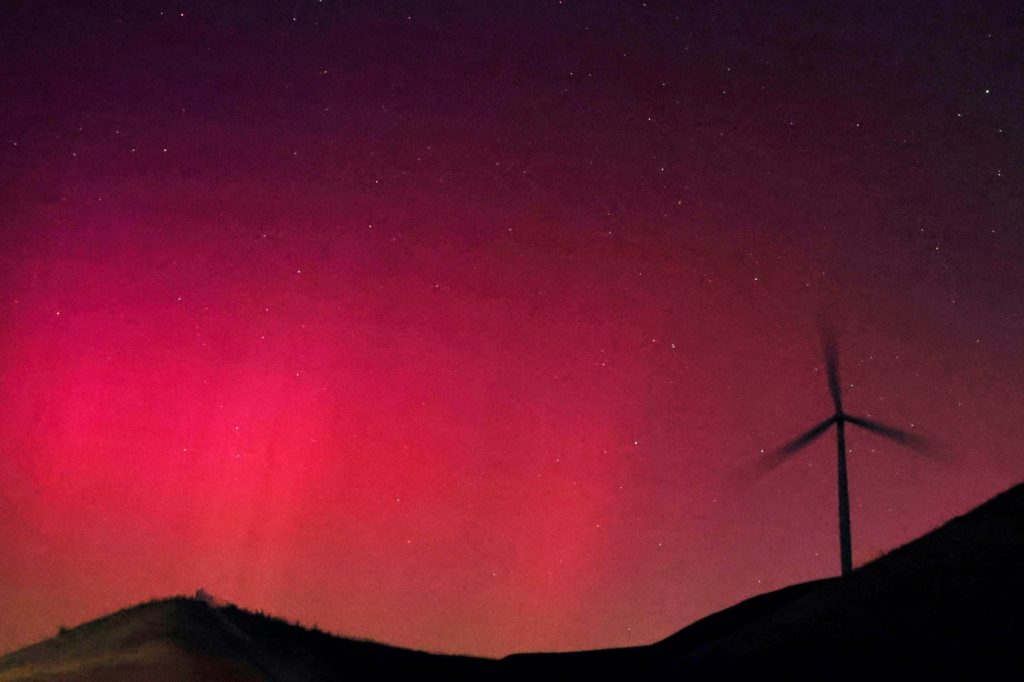A series of solar flares and coronal mass ejections from the sun have the potential to create dazzling auroras that may be seen as far south as Alabama and Northern California but also disrupt communications on Earth tonight and over the weekend, according to the National Oceanic and Atmospheric Administration’s Space Weather Prediction Center.
The center, which is a division of the National Weather Service, observed conditions of an extreme geomagnetic storm at 6:54 p.m. ET on Friday evening, reaching a level 5 out of 5 severity. The last time a solar storm of this magnitude reached Earth was in October 2003, resulting in power outages in Sweden and damaged power transformers in South Africa, according to the center.
Signs of a severe geomagnetic storm, or level 4, were first observed by scientists at the center at 12:37 p.m. ET, when a major disturbance was detected in Earth’s magnetic field. Previously, the center issued a geomagnetic storm watch on Thursday evening, the first such watch issued since January 2005.
Photos: Aurora borealis from the Bay Area and far beyond
But the forecast was upgraded after scientists observed G5, or extreme geomagnetic storm, conditions Friday evening.
As the sun nears the peak of activity in its 11-year cycle, known as solar maximum, later this year, researchers have observed increasingly intense solar flares erupting from the fiery orb.
Increased solar activity causes auroras that dance around Earth’s poles, known as the northern lights, or aurora borealis, and southern lights, or aurora australis. When the energized particles from coronal mass ejections reach Earth’s magnetic field, they interact with gases in the atmosphere to create different colored light in the sky.
NASA’s Solar Dynamics Observatory captured this image of a solar flare in extreme ultraviolet light on May 2. The flare is the bright flash toward the upper middle area of the sun.(NASA/SDO via CNN Newsource)
The Space Weather Prediction Center tracked multiple strong flares emitting from a large cluster of sunspots on the solar surface since Wednesday. The cluster is 17 times the diameter of Earth.
Scientists also observed at least seven coronal mass ejections, or large clouds of ionized gas called plasma and magnetic fields that erupt from the sun’s outer atmosphere, releasing from the sun in the direction of Earth. These significant outbursts are expected to continue through Sunday.
Related Articles
Photos: Aurora borealis from the Bay Area and far beyond
Solar storm brings northern lights to Bay Area; no serious disruption to power grid reported
Huge solar storm: Northern lights possible in California, sunspot visible with glasses
NASA watchdog report: 100+ cracks on heat shield biggest threat to human moon mission
Russia vetoes UN resolution against nuclear space race
The center’s space weather scale covers three categories: solar flares that cause high-frequency radio blackouts, geomagnetic storms and solar radiation storms.
The current solar activity is capable of producing a solar radiation storm, according to Shawn Dahl, the service coordinator for the Space Weather Prediction Center.
“That’s the very low end of our scale,” Dahl said. “It does mean things to some rocket launch operations and satellite operators. But at this point in time, it’s nothing that can’t be handled as far as we understand it. The potential for stronger events of course does exist and we’ll see if any materialize.”
The peak of the geomagnetic storm activity for Earth could occur between 2 a.m. and 5 a.m. ET on Saturday, the center has forecasted.
The center referred to this as “an unusual event.” There have been three geomagnetic storms since December 2019, but all of them have been considered weak, according to the center.
Geomagnetic storms driven by the sun in recent months have caused auroras to be visible in places where they are rarely seen, including as far south as New Mexico, Missouri, North Carolina and California in the United States, and the southeast of England and other parts of the United Kingdom.
The solar storm caused a dazzling aurora australis to light up the sky over New Zealand around 6:20 a.m. local time.
Depending on the location, the auroras may not always be visible overhead, but keep an eye on the horizon, experts say, because they may create a colorful display there as well.
Even if auroras aren’t visible in the sky, experts at the center recommend taking images of the sky with your phone because the images may capture what you can’t see with the naked eye.
“A severe storm would mean that the aurora will likely be visible in southern Michigan,” said Michael Liemohn, a professor of climate and space sciences and engineering at the University of Michigan in Ann Arbor, in a statement. “Get away from city lights to a place with clear skies and you should be able to see the green or red glow of aurora across the sky.”
The effects of geomagnetic storms
When coronal mass ejections are directed at Earth, they can cause geomagnetic storms, or major disturbances of Earth’s magnetic field.
“Geomagnetic storms can impact infrastructure in near-Earth orbit and on Earth’s surface, potentially disrupting communications, the electric power grid, navigation, radio and satellite operations,” according to the Space Weather Prediction Center. “(The center) has notified the operators of these systems so they can take protective action.”
The center has notified operators in these areas to take action to mitigate the potential for any impacts, which include the possibility of increased and more frequent voltage control problems. Other aspects operators will monitor include a chance of anomalies or impacts to satellite operations and frequent or longer periods of GPS degradation.
In turn, the operators also make sure power lines are performing as expected, ensure that alternate equipment is available and functioning, and any maintenance is suspended, Dahl said.
“But the key element here is that they know what’s causing anything if the situation unfolds that will allow us to be able to take the proper steps to help mitigate and control any developing problems,” Dahl said.
When coronal mass ejections arrive, they carry their own magnetic field, which can overwhelm power lines and induce electrical currents, so operators will monitor for any signs of such activity, said Rob Steenburgh, space scientist at the Space Weather Prediction Center.
“When we’re talking about impacts to the power grid, we’re talking about the high voltage transmission lines. That’s where these currents can develop. It’s not on any line going from a small transformer to their home,” Dahl said. “It’s only really developing on the high voltage transmission lines, which creates problems for the major transformers that control distribution.”
Solar storms generated by the sun can also cause radio blackouts and even pose risks for crewed space missions.
NASA’s Space Radiation Analysis Group is dedicated to monitoring conditions for astronauts aboard the International Space Station. If there appears to be an increased radiation risk, the astronauts can move to parts of the station that are more well-shielded.
“During the recent solar weather activity that measured higher than originally predicted aboard the International Space Station on May 11, the Expedition 71 crew was told to avoid lower shielded areas of the space station out of an abundance of caution,” according to a May 14 update released by the federal agency.
The center warned that additional solar activity could cause geomagnetic storm conditions to be ongoing through the weekend.
So far, researchers have obseverd only three severe geomagnetic storms during the current solar cycle, which began in December 2019, according to the center.
Experts at the center say they are a “little concerned,” but mainly because such events are rare.
The team likened it to being prepared for a summer storm: Keep batteries and a weather radio on hand in the event of a power outage, but said that people don’t need to “do anything out of the ordinary” to prepare for space weather. No disruption to internet or cellphone service is expected. And any disruption to GPS is not expected to be prolonged, as long as providers can quickly lock back on to satellite signals, according to experts at the center.
Tracking space weather
Every 11 years or so, the sun experiences periods of low and high solar activity, which is associated with the amount of sunspots on its surface. The sun’s strong and constantly shifting magnetic fields drive these dark regions, some of which can reach the size of Earth or larger.
Over the course of a solar cycle, the sun will transition from a calm to an intense and active period. During the peak of activity, called solar maximum, the sun’s magnetic poles flip. Then, the sun will grow quiet again during a solar minimum.
Solar maximum is expected to peak through mid- to late 2024, but the sun will remain active for a couple of years afterward.
Teams at the Space Weather Prediction Center use data from ground and space-based observatories, magnetic maps of the solar surface, and ultraviolet observations of the sun’s outer atmosphere to determine when the sun is most likely to send out solar flares, coronal mass ejections and other space weather that could affect Earth.
Solar flares can affect communications and GPS almost immediately because they disrupt Earth’s ionosphere, or part of the upper atmosphere.
Energetic particles released by the sun can also disrupt electronics on spacecraft and affect astronauts without proper protection within 20 minutes to several hours.
The material sent speeding away from the sun during coronal mass ejections can arrive at Earth between 30 and 72 hours afterward, causing geomagnetic storms that affect satellites and create electrical currents in the upper atmosphere that travel through the ground and can have an impact on electric power grids.
The storms also affect flight patterns of commercial airlines, which are instructed to stay away from Earth’s poles during geomagnetic storms due to loss of communication or navigation capabilities.
Extreme storms have occurred before, such as one that knocked out the power grid in Quebec in 1989 and the Carrington Event of 1859.The latter remains the most intense geomagnetic storm ever recorded, causing telegraph stations to spark and catch fire.
If such an event were to occur today, it could cause trillions of dollars’ worth of damage and bring down some power grids for a substantial amount of time.
The-CNN-Wire
& © 2024 Cable News Network, Inc., a Warner Bros. Discovery Company. All rights reserved.


